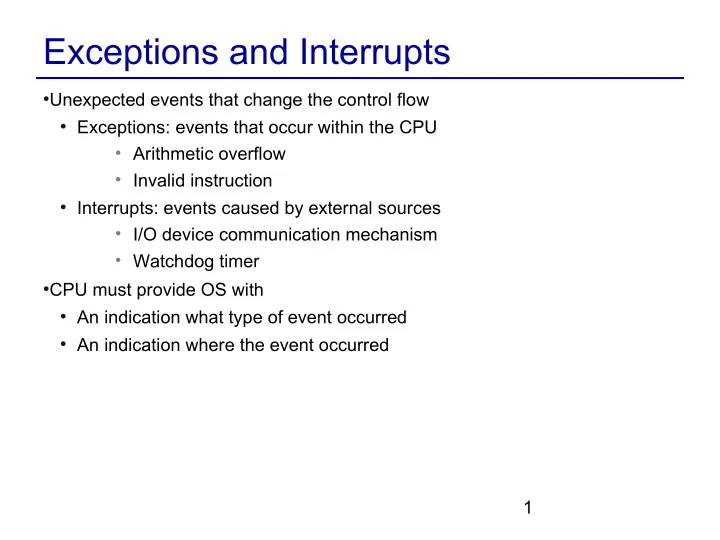

Exceptions and Interrupts ● Unexpected events that change the control flow ● Exceptions: events that occur within the CPU • Arithmetic overflow • Invalid instruction ● Interrupts: events caused by external sources • I/O device communication mechanism • Watchdog timer ● CPU must provide OS with ● An indication what type of event occurred ● An indication where the event occurred 1
Handling Exceptions ● CPU provides the address of the instruction where the event occurred ● The Exception Program Counter (EPC) ● CPU might undo addition of 4 from fetch cycle ● Two ways to indicate the type of event – Cause Register: CPU provides the OS with a value in a register that indicates what caused the event – Vectored: CPU starts executing at an address that depends on the event type 2
Handling Exceptions – Cause Register ● The EPC contains the address of the instruction ● The Cause register contains a value that indicates what type of event occurred ● For example: Invalid Instruction: Cause = 0x0000000A Arithmetic Overflow: Cause = 0x0000000C ● When an exception or interrupt occurs: ● The CPU sets the EPC and Cause registers ● Starts executing at a defined address ● 0x80000180 in MIPS ● The OS determines how to handle the event ● MIPS handles exceptions and interrupts this way 3
Handling Exceptions – Vectored ● EPC contains instruction address ● No Cause register ● CPU goes to an address based on the event type ● Looks at the interrupt vector (or description) table ● For example: Arithmetic Overflow: PC = 0xC0000000 Undefined Instruction: PC = 0xC0000020 ● When an exception or interrupt occurs: ● The CPU sets the EPC and looks up interrupt handler address ● Starts executing the interrupt handler ● The handler returns to the program when done 4
Interrupt Classification ● Internal or external ● Internal interrupts caused by instruction ● Overflow ● Invalid instruction ● External interrupts caused by sources outside CPU ● Device request ● Bus error ● Precision ● Precise interrupts • Instructions before interrupt completed • Instruction that caused the interrupt and those after have not changed the CPU state ● Imprecise interrupts cannot guarantee these conditions 5
Control Unit Adaptation ● Control Unit of CPU must be modified to detect and handle exceptions and interrupts ● Logic necessary to detect exceptions ● Check for invalid opcode/function field values ● ALU modified to detect overflow ● Exception handling address input to PC multiplexer ● Control signals for Cause and EPC registers ● Use ALU to compute PC of current instruction ● PC updated to PC+4 during fetch cycle ● Compute PC+4-4=PC during exception cycle 6
State Diagram with Exceptions 7
Recommend
More recommend